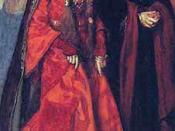POEM : On Sitting Down to Read King Lear Once Again
O golden-tongued Romance with serene lute!
Fair plumed Syren! Queen of far away!
Leave melodizing on this wintry day,
Shut up thine olden pages, and be mute:
Adieu! for once again the fierce dispute,
Betwixt damnation and impassion'd clay
Must I burn through; once more humbly assay
The bitter-sweet of this Shakespearian fruit.
Chief Poet! and ye clouds of Albion,
Begetters of our deep eternal theme,
When through the old oak forest I am gone,
Let me not wander in a barren dream,
But when I am consumed in the fire,
Give me new Phoenix wings to fly at my desire.
COMMENTARY :
The poem under study was written in 1818 after the completion of John Keats's 4,000-line poem Endymion. We are facing a traditional and fixed form of poem as "Sitting Down to Read King Lear Once Again" is an Elizabethan sonnet composed of fourteen lines which are divided up into three quatrains, that is four-line stanzas, and a final couplet -or two lines of verse.
The rhyming pattern is abba, cddc, efef, gg as, notably "Lute" (l.1) rhymes with "mute" (l.4), "far-away" (l.2) with "day" (l.3) and "dispute" (l.5) with "fruit" (l.8). Moreover, the lines are iambic pentameters since they contain five iambic feet for instance :
_ / _ / _ / _ / _ /
"O Gol/den-tongued /Romance, /with se/rene Lute!"
Like most of Keats's poems, this text deals with the speaker's encounter with something which incites him to meditate and alters significantly his vision of life. It is the perusal of King Lear written by William Shakespeare in 1605 which affects him this time and this is not a first reading judging by the presence of "Once Again" in the title. Keats was a...


